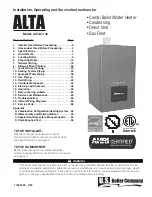
whl-648 Rev. 001 Rel. 003 Date 10.8.19
58
Figure 53 - Flame Sight Glass
Part 11 - Start-Up
A. Check / Control Water Chemistry
Chemical imbalance of the water supply may affect efficiency and
cause severe damage to the boiler and associated equipment. It is
important that the water chemistry on both the domestic hot water
and central heating sides are checked before installing the boiler.
Water quality must be professionally analyzed to determine whether
it is necessary to treat the water. Various solutions are available to
adjust water quality. Adverse water quality will affect the reliability
of the system. In addition, operating temperatures above 135
o
F will
accelerate the build-up of lime scale and possibly shorten boiler
service life. Failure of an boiler due to lime scale build-up, low pH, or
other chemical imbalance IS NOT covered by the warranty.
CAUTION
Thoroughly clean and flush any system that has used glycol before
installing the boiler. Provide the customer with a material safety data
sheet (MSDS) on the fluid used.
CAUTION
To ensure extended service life, it is recommended to test water quality
prior to installation. Listed below are some guidelines.
The water must be potable, free of corrosive chemicals, sand, dirt,
and other contaminates. It is up to the installer to ensure the water
does not contain corrosive chemicals or elements that can damage
the heat exchanger. Potable water is defined as drinkable water
supplied from utility or well water in compliance with EPA secondary
maximum contaminant levels (40 CFR Part 143.3). If the water contains
contaminants higher than outlined by the EPA, water treatment is
recommended and additional, more frequent maintenance may be
required. See the table below.
If you suspect that your water is contaminated in any way, discontinue
use of the boiler and contact an authorized technician or licensed
professional.
B. Check for Gas Leaks
WARNING
!
Before starting the boiler, and during initial operation, smell near
the floor and around the boiler for gas odorant or any unusual odor.
Remove boiler front door and smell interior of boiler enclosure. Do
not proceed with startup if there is any indication of a gas leak.
Repair any leaks at once.
PROPANE Boilers ONLY – The propane supplier mixes an odorant
with the propane to make its presence detectable. In some
instances the odorant can fade, and the gas may no longer have
an odor. Before startup (and periodically thereafter), have the
propane supplier verify the correct odorant level in the gas.
*NOTE:
It is recommended to clean the heat exchanger at least
once a year to prevent lime scale buildup. To clean the heat
exchanger, follow the maintenance procedure in this manual.
Clean system to remove sediment*
1. You must thoroughly flush the system (without boiler connected)
to remove sediment. The high-efficiency heat exchanger can be
damaged by buildup or corrosion due to sediment.
2. For zoned systems, flush each zone separately through a purge
valve. (If purge valves and isolation valves are not already installed,
install them to properly clean the system.)
3. Check return Y strainer (if installed). Remove and clean sediment
and debris if necessary.
4. Flush system until water runs clean and you are sure piping is free
of sediment.
NOTE: Boiler failure due to improper water chemistry is not
covered by warranty.
Table 34 - Water Quality Specifications
If you discover any evidence of a gas leak, shut down the boiler
at once. Find the leak source with a bubble test and repair
immediately. Do not start the boiler again until the leak is repaired.
Failure to comply could result in substantial property damage,
severe personal injury, or death.
Do not use petroleum-based cleaning or sealing compounds in the
boiler system. Damage to elastomer seals and gaskets in the system
could occur, resulting in substantial property damage.
CAUTION
Contaminant
Maximum Allowable Level
Total Hardness
(Residential Use - Below 140
o
F
water temperature)
200 mg/l
(12 grains/gallon)
Total Hardness
(Commercial Use - Above 140
o
F
water temperature)
120 mg/l
(7 grains/gallon)
Aluminum
0.05 to 0.2 mg/l or PPM
Chloride
100 mg/l or PPM
Copper
1 mg/l or PPM
Iron
0.3 mg/l or PPM
Manganese
0.05 mg/l or PPM
pH
6.5 - 8.5
Sulfate
205 mg/l or PPM
Total Dissolved Solids (TDS)
500 mg/l or PPM
Zinc
5 mg/l or PPM
Dissolved Carbon Dioxide (CO2)
15 mg/l or PPM
Summary of Contents for WBRC 140 Series
Page 21: ...whl 648 Rev 001 Rel 003 Date 10 8 19 21 E Applications Figure 10 Piping Symbol Legend ...
Page 40: ...whl 648 Rev 001 Rel 003 Date 10 8 19 40 Figure 33 Electrical Wiring Diagram ...
Page 41: ...whl 648 Rev 001 Rel 003 Date 10 8 19 41 Figure 34 Ladder Diagram ...
Page 81: ...whl 648 Rev 001 Rel 003 Date 10 8 19 81 Notes ...
Page 82: ...whl 648 Rev 001 Rel 003 Date 10 8 19 82 This Page Intentionally Left Blank ...
Page 83: ...whl 648 Rev 001 Rel 003 Date 10 8 19 83 This Page Intentionally Left Blank ...
















































